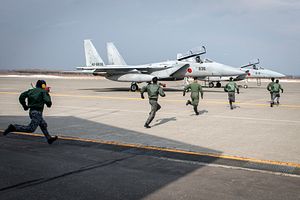The number of intercepts made by Japan Air Self Defense (JASDF) fighter jets decreased by 23 percent in fiscal year 2017 in comparison to the previous year, Japan’s Ministry of Defense (MoD) said on April 13.
Overall, the JASDF scrambled fighter jets 904 times in response to unidentified aircraft approaching Japanese airspace during the last fiscal year that ended in March.
Out of the total of 904, 500 scrambles occurred in response to People’s Liberation Army Air Force (PLAAF) aircraft and 390 were prompted by Russian military planes.
This constitutes a decline of 41 percent for PLAAF aircraft, but a 29 percent increase of intercepts of Russian planes. Chinese and Russian aircraft respectively accounted for 55 percent and 43 percent of total intercepts in fiscal year 2017.
As I reported last June:
JASDF scrambled its fighter jets 1,168 times in fiscal year 2016, 301 times in response to Russian military aircraft. Fiscal year 2015 saw 873 overall sorties, with 288 in reaction to Russian military aircraft. During fiscal year 2014, Japan scrambled fighter jets 943 times, a record 473 of which were due to incursions by the the Russian Aerospace Forces.
In fiscal year 2017, the PLAAF flew a record number of missions over the Miyako Strait, located between the Japanese islands of Miyako and Okinawa.
Overall, the MoD recorded 36 flights from March 2016 to 2017. Consisting of a small passageway with international waters and airspace, the strait is one of the principal gateways for the People’s Liberation Army Navy (PLAN) to the Pacific Ocean.
The PLAAF last sent four Xian H-6K long-range bombers, one Shaanxi Y-8 electronic countermeasures aircraft, one Tupolev Tu-154MD electronic intelligence plane, and at least two Sukhoi Su-35 multirole fighter jets through the Miyako Strait on March 23. The JASDF scrambled Mitsubishi F-15J all-weather air superiority fighters in response.
For the majority of intercepts, the JASDF scrambles F-15J fighter jets, 215 of which (including the upgraded F-15DJ/F-15J Kai variants) are currently in service.
In 2016, the JASDF has doubled the number of fighter jets dispatched for each intercept of foreign military aircraft approaching Japanese airspace from two to four.
“The doubling of aircraft used for scrambles against foreign military aircraft will put additional pressure on an already overstretched JASDF,” I explained elsewhere.
“Unless Japan steps up its procurement process and accelerates the introduction of new aircraft (e.g. the F-35), the JASDF will likely face a shortage of fighter aircraft in the 2020s.”
The JASDF will be needing at least 100 additional fifth-generation fighter jets by the 2030s to guarantee continued around-the-clock protection of Japan’s airspace.
The JASDF is currently in the process of inducting 42 F-35A Lightning II fifth-generation stealth fighter jets and reportedly plans to order 25 more by the end of the year. A contract for an additional 100 fifth-generation aircraft is expected to be awarded in the near future.































